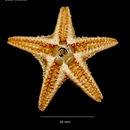In 1911, Walter K. Fisher published a bulletin for the United States National Museum descrbing various Asteroidea, or sea stars. Through examining several specimens, Fisher published this description:
“
Abactinal membrane capable of inflation. Disk and basal part of ray [arm], as far as outer edge of lateral
cribriform organ covered with spaced delicate,
terete spinelets, each invested in a thin membrane. In one specimen the spinelets extend a short distance beyond cribriform organ. They are about 0.5 mm. high and spring from simple subcircular perforated plates embedded in the abactinal membrane. As a rule these plates have an irregular outline and are about one-half to two-thirds as broad as height of spinelet. The plates are more or less spaced and irregularly between them emerge the
papulae, singly. They have the appearance of being about as numerous as the spinelets. The central prolongation of the
integument or
peduncle contains crowded plates with rudimentary spinelets as in
tenebrarius*, and no papulae. In the integument of ray beyond the limit of spinelets are simple subcircular perforated plates usually uneven or more or less toothed on margin; occasionally smooth. The plates are somewhat larger than those of disk, the largest being 0.6 mm. in diameter, a small one about 0.3 mm.; whereas on the spiniferous area at base of ray the largest are 0.35 to 0.4 mm., and are thicker in the center. The abactinal area varies in width on ray, even in same specimen, according as marginal plates are arched inward. Occasionally two or three isolated spinelets occur on outer part of ray.
Marginal plates in form about as in
E. tenebrarius. Superomarginals eight or nine, each with an upright glassy tipped spinule on upper edge of plate, these about as high as plate when perfect and decreasing in size toward end of ray. Occasionally a second shorter spinule is present. Inferomarginals the same in number as superomarginals, confined to side wall of ray and longer than high.
Terminal plate fairly large, deeply concave toward abactinal area. There is one terminal spinule, and below at either side of end of furrow, one; behind terminal
spinule on abactinal edge of plate a row of two to five spinelets on either side…
Cribriform organs large, always three. The median has about twenty-four
lamellae, the lateral about twenty. Their structure does not appear to be different from those of
tenebrarius, although there is more tendency for the plate-like spinelets to remain independent.
Adambulacral plates shaped as in
tenebrarius and with two
acicular skin-covered spinelets on the margin. Of these one stands on the prominent
adoral end of plate, the other a trifle shorter at about the middle of concave margin or a little nearer adoral end. The longest spinelet is about as long as plate; the other is the homologue of the segmental
papilla of
E. crassus and
E. tenebrarius.
Mouth plates very prominent actinally, a little wider at outer end than in
tenebrarius. Armature consists of an odd acicular spinule at inner end of combined pair and along the free margin a series of two to five similar spinelets increasing slightly in size toward first adambulacral.
Actinal interradial areas about as in
tenebrarius, but covered with spaced skin-covered spinelets very similar in character and size to those of abactinal surface. These spinelets vary in length and are more numerous near the marginal plates than in the inner angle. Intermediate plates extend to fourth inferomarginal. At outer end of combined mouth plates the triangular end of the
odontophore is visible. The triangular lower end of ambulacral
ossicles is visible, as in
tenebrarius, between the inferomarginal and adambulacral plates, forming a series extending to tip of ray.
Madreporic body large, about as wide as median cribriform organ to which it is adjacent.” (Fisher, 1911, p. 29-30).
*Note:
Eremicaster tenebrarius is now accepted as
Eremicaster crassus (Mah, 2009).

